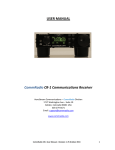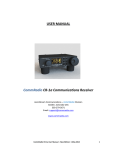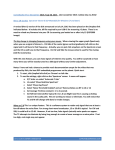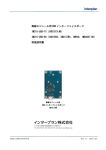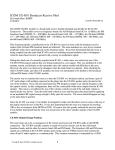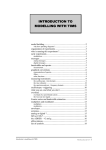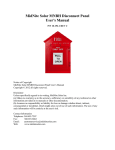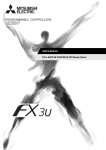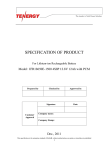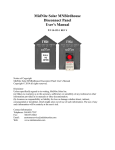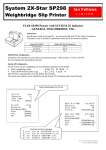Download USER MANUAL CommRadio CR-1a Communications Receiver
Transcript
USER MANUAL CommRadio CR-1a Communications Receiver (All operating instructions and specifications apply to earlier CR-1, except I-Q over USB) AeroStream Communications – CommRadio Division New Castle, Colorado USA 303-279-3671 Email: [email protected] www.commradio.com CommRadio CR-1a User Manual – Rev 1 Edition: 15 July 2015 1 A. Introduction. Thank you for purchasing a CR-1a. The CR-1a is meant to be intuitively obvious and fun to use; not requiring a manual close at hand. The CR-1a was designed to have minimal controls and no deep-menu options, yet be fast and efficient when changing bands and modes. This manual is intended to describe the basic controls and some features which are not obvious. Firmware and Manual Updates. Contact [email protected] to register your warranty and to automatically receive automated email notices when updates to firmware or this manual are available. You can always find the latest on our website www.commradio.com. Definitions: CW: CCW: Push: Click: Increment: Scrolling: Clockwise rotation of a knob. Counter-clockwise rotation of a knob. Momentarily push inward on a knob (<0.5 seconds) Rotate the Menu knob (1) one detent CW or CCW. Rotate the Tuning knob (3) a few degrees CW or CCW. use [<] and [>] keys to step through options shown on display. Symbols: Bold square brackets [ ] denote user interaction with knobs and keys: Example: [BAND] denotes pushing the BAND key in the picture above. CommRadio CR-1a User Manual – Rev 1 Edition: 15 July 2015 2 B. Front Panel Controls 1: On/Off - Volume Control - Menu Knob [M] Description: Rotary Encoder-12 detents per revolution with push-in switch. On/Off Control: Push [M] to turn - ON. Hold [M] to turn - OFF • Volume (default): a click of the knob independently controls the Head-set and speaker volume. There is no indication of the volume level on the display. • Menu: Push-In [M] momentarily for Menu Selections that include: o Spectrum: Frequency Range, Bands, Filters, Mode Selections o Controls: AGC, Squelch, Brightness o Configuration: Timing, Time-out, SWL-Amateur, Continent, Software Version 2: Display: 128 x 64 pixel x 1.5”diagonal OLED. Organization: a. b. c. d. e. f. Frequency Band Mode (active: highlighted box) Signal Strength: S-Units Filter Bandwidth Power Status Icons CommRadio CR-1a User Manual – Rev 1 Edition: 15 July 2015 3 3: Frequency Tuning Knob [T] Description: Rotary Encoder-15 increments (no detents) per revolution With push-in switch. Primary Use: Frequency Selection. Secondary Use: Push once to highlight frequency cursor. Then, rotate to re-position frequency cursor. Push again to exit. 4: Key-Pad Radio Controls: [BAND] Change Bands [MODE] AM-CW-LSB-USB-FM [STEP] Frequency Stepping [MEM] Frequency Save-Recall [<] Left Arrow-Selection [>] Right Arrow-Selection [<] and [>] positions the highlighted cursor as a default. When [BAND] [MODE] [STEP] or [MEM] are pushed, then [<] and [>] are used for associated selections by viewing the change on the display. [LAST]: Holding the [<] key will return the radio to the last frequency that was maintained for at least 5 seconds prior to pushing the key. This allows a rapid return to a prior frequency, regardless of band. 5. Headphone Socket: 3.5 mm (1/8”) female-stereo-socket. Conventionally wired for typical ear-buds or headphones. Delivers: 40 mW into 16 Ohms. Use this output for amplified speakers or sound-card interfaces. CommRadio CR-1a User Manual – Rev 1 Edition: 15 July 2015 4 C. Operating the CR-1a 1. On/Off - Volume - Menu Knob [M] • ON: Push-In momentarily until………………….. In 4 seconds the CR-1a is ready and displays the last frequency and mode used before the last shut-down. • OFF: Push-In and hold until………………………… Release and then wait 3 seconds……….. If the CR-1a does not shut down in 3 seconds, hold-in (about 6 seconds) to force shut down. 2. Tuning Step Size - Frequency Cursor Positioning • Cursor Positioning – Decade Control The solid-highlighted boxes below indicate the position of the Cursor. When the tuning knob [T] is rotated CW or CCW, the tuned frequency changes accordingly. There are 2 ways to change the position of the cursor: • • • Use [<] or [>] to position the cursor. This is the default use of the arrow keys. Push [T] (momentarily) and rotate CW or CCW. Push [T] again to exit. Note the sequence of successive cursor position changes. Push [>] 3 times Push [>] 3 more times CommRadio CR-1a User Manual – Rev 1 Edition: 15 July 2015 5 • Cursor: Open Box – Standard Frequency Steps – HF and FM-Broadcast An open box indicates a standard frequency step size within a band. This occurs only if ‘Automatic Tuning-Mode’ is selected (see Menu below). • 5 kHz step in international broadcast bands (10.000 MHz). 200 kHz step in US FM broadcast band (88.100 MHz). Cursor: Highlighted Box - Standard Frequency Steps - VHF & UHF Highlighted for 25.0 and 12.5 kHz frequency steps, depending on band. 3. Changing Bands [BAND] • • • • • • Push [BAND] Note highlighted box indicating Amateur or Shortwave banding and the current band. < or > to scroll through associated bands. Or: push [BAND] repetitively to scroll upward through bands. Amateur and Shortwave listening bands are listed in section G. To exit: rotate [T], or allow timeout to occur. 4. Changing Modes [MODE] • • • • Push [MODE] < or > to scroll through modes CW-LSB-USB-AM and FM ( FM only above 25 MHz) Or: push [MODE] repetitively to scroll through available modes. To exit: rotate [T], or timeout. CommRadio CR-1a User Manual – Rev 1 Edition: 15 July 2015 6 5. Frequency Stepping [STEP] The CR-1a Steps sequentially through frequencies and does not stop on a channel or frequency if a signal is present (not a scanner). • • • • • Push [STEP] to start stepping in increments corresponding with the cursor position. Cursor range: 100 kHz to 10 Hz. Steps within the selected band boundaries. To stop stepping: Push [STEP] or rotate [T]. To reverse stepping direction (while stepping): [<] or [>] 6. Memory [MEM]: Save-Recall-Step • • Save a frequency example: Save 18.150 MHz to Memory page 2, slot (memory location) 4. Push [MEM]. There are 8 pages of memory. Each page has 8 slots. Use [<] or [>] to index through pages. Select page 2. Note the tuned frequency is shown in upper right of display. Push [MEM] to enter the selected page. Use [<] or [>] to index through memory slots. Hold [MEM] 2 seconds. Exit options (return to Main display): • Rotate [T] 1 increment CW or CCW. The frequency will not change until next increment. • Timeout (see Menu Timeout selections on page 11). Recall a frequency example: Recall 18.150 MHz from Memory page 2, slot 4. Push [MEM]. There are 8 pages of memory. Use [<] or [>] to index through pages. Select page 2. Note the tuned frequency is shown in upper right of display. Push [MEM] to enter the selected page. Use [<] or [>] to index through memory slots. Select slot 4. Push [MEM] (momentarily). Exit options if frequency not selected: • Rotate [T] 1 increment CW or CCW. CommRadio CR-1a User Manual – Rev 1 Edition: 15 July 2015 7 D. MENU. Push the Menu Knob [M] inward momentarily to enter MENU options. 1. FILTER Bandwidth Selections: are the most frequent and therefore the fastest to access using the push-in switch on the Menu knob [M]. The first push [M] defaults to Filter selections: 5 kHz (total bandwidth) is presently selected: A second push [M] highlights the current selection: Rotate [M] CW or CCW to view the available filter bandwidths. The selection is made immediately and is audible. Exit options: Push [M] to continue clicking to next menu selection Rotate [T] 1 increment CW or CCW. The frequency will not change until next increment. Timeout (see Menu Timeout selections on page 11). Bandwidth selections are MODE dependent as follows: CW 500 Hz, 1.0, 1.8, 2.2 & 2.6 kHz SSB 1.8, 2.2 & 2.6 kHz AM 2.6, 5, 7.5, & 15 kHz NBFM 15 & 25 kHz FM Broadcast 200 kHz (USA) 100 kHz (Europe/Asia) CW clicks of Menu Knob: 2. Frequency Range Selection (HF-VHF-UHF): Next CW Click after the first push of [M]: Push [M] to highlight. Then Rotate [M] to select HF, VHF or UHF Rotate [T] or timeout to return to Main display: CommRadio CR-1a User Manual – Rev 1 Edition: 15 July 2015 8 Exit options: • Push [M] to continue clicking to next menu selection. • Rotate [T] 1 increment CW or CCW. The frequency will not change. • Timeout (see selections below). • Above screen images indicate selection of VHF or UHF after timeout. 3. Band Key Configuration: Next CW Click of [M]: Rotate [M] to select Shortwave or Amateur [BAND] key configuration. Same exit options. 4. Automatic or Manual Tuning-Mode Controls: Next CW Click of [M]: Switch between automatic and manual frequency step size and mode while tuning through amateur and shortwave bands. Automatic: Provides automated mode changes and standard frequency steps. Provides: Rapid Tune for speed-tuning (page 12). To Select: Push [M] to highlight: Rotate [M] to select Automatic or Manual. Same exit options. CommRadio CR-1a User Manual – Rev 1 Edition: 15 July 2015 9 CCW Menu Options: are accessed by pushing [M] to enter Menu from the main frequency display. (Filter bandwidth selection is always the default). Rotating [M] CCW accesses options that are less frequently used. Note: all menu items are sequential and can be accessed by CW or CCW rotation. 5. AGC Speed: AGC attack time equals AGC decay time. There are 3 speeds available. Push [M] to enter Menu options (filter bandwidth always the default) and rotate [M] 1 click CCW. Exit options: • Push [M] to continue clicking to next menu selection. • Rotate [T] 1 increment CW or CCW. • Timeout. 6. HF Squelch Control: is available up through 30.0 MHz Rotate [M] 1 click CCW past AGC SPEED. Push [M] to highlight. Rotate [M] CW to advance or CCW to retard Squelch. Same Exit options. 7. VHF-UHF Squelch Control: Rotate [M] 1 click CCW past HF SQUELCH. Push [M] to highlight. Rotate [M] CW to advance or CCW to retard Squelch. Same Exit options. CommRadio CR-1a User Manual – Rev 1 Edition: 15 July 2015 10 8. Display Brightness Control: Rotate [M] 1 click CCW from VHF-UHF Squelch. Push to highlight. Rotate [M] to adjust brightness. Same exit options. 9. Frequency and Memory Step Time: Steps in increments associated with cursor position. The cursor position is highlighted (100 kHz – 10 Hz): Rotate [M] 1 click CCW from Brightness. Push to highlight. Rotate [M] to select: 250, 500 mS, 1-2-5-10 seconds Same exit options. Illustration below-left: Stepping sequentially through saved frequencies within a memory page. Illustration above-right: Stepping through discrete frequencies (cursor not highlighted). 10. Menu Timeout from menu options and the [BAND] [MODE] and [MEM] keys is user controllable: 2, 3, 4, and 5 seconds: Rotate [M] 1 click CCW from Step Time. Push to highlight. Rotate [M] to select: 2, 3, 4, 5 seconds. Same exit options. CommRadio CR-1a User Manual – Rev 1 Edition: 15 July 2015 11 11. Rapid Tune is a feature to rapidly tune across a band in 1 kHz increments when the cursor is normally in the 100 Hz position. This feature is available when ‘AUTOMATIC’ has been selected. Rotate [M] 1 click CCW from Timeout. Push to highlight. Rotate [M] to select: OFF, 2, 4, 6, 8, 10 revolutions. Same exit options. With the cursor in the 100 Hz position, after ‘X’ rotations of [T], the cursor automatically moves to the 1 kHz position until rotation stops. Then the cursor returns to the 100 Hz position to allow for fine-tuning. 12. Broadcast Band Plans for USA or the World (Europe/Asia) Frequency tuning steps for: MW are automatically adjusted (10 or 9 kHz) HF amateur allocations. VHF Broadcast (200 or 100 kHz channel spacing) Rotate [M] 1 click CCW from Rapid Tune. Push to highlight. Rotate [M] to select: USA or EUROPE/ASIA Same exit options. 13. Firmware Versions and embedded serial number: Rotate [M] 1 click CCW from BROADCAST. Push to highlight. Rotate [M] to view DSP & PIC version. Same exit options. CommRadio CR-1a User Manual – Rev 1 Edition: 15 July 2015 12 E. Display Power and Lock Icons Low Battery Normal Battery USB Charging Power Plug Hold [>] to lock and unlock Tuning Knob Function CommRadio CR-1a User Manual – Rev 1 Edition: 15 July 2015 13 F. Rear Panel Jacks 6: Power Input Jack. Accepts 5 mm diameter barrel with 2.1 mm diameter center pin (positive). Reverse polarity protected. DC input voltage: 6.0 to 18.0 VDC. Minimum rating of user-supplied power supply: • • 2 W (with internal battery removed) 5 W (with internal battery charging and CR-1a ON) 7: Mini-B USB Jack. • Supplies power to the CR-1a and charges internal battery. • USB connection to Windows PC for updating internal firmware. • USB connection for I-Q data and radio controls. Notes: Power input jacks 6 & 7: • • • • • With the internal battery installed, either power input jack will charge the battery while the CR-1a is OFF or ON. Both Jacks can be used simultaneously. If both engaged, power drawn only from power input jack 6. Jacks can be connected or disconnected while the CR-1a is ON or OFF USB Power consumption automatically limited to 2.5 W per USB-Powered PC requirements. Fastest battery charging is via power input jack 6. CommRadio CR-1a User Manual – Rev 1 Edition: 15 July 2015 14 8: External Speaker: Internal amplifier delivers 0.8 Watts into 8 Ohm Speaker. 3.5 mm (1/8”) female-mono-socket (tip and ring). • • Both speaker wires connected to the tip and ring of the external speaker socket MUST be un-grounded to avoid internal amplifier damage. Not intended for sound-card or amplified speakers. See Headset Jack on page 3. 9: MW-HF Antenna Port 1: BNC Female – 50 Ohm. 10: VHF-UHF Antenna Port 2: BNC Female – 50 Ohm. 11: External Chassis Ground Connection: 4/40 Phillips pan-head screw with 1 lockwasher and 2 flat-washers to hold wires and lugs. The CR-1a is designed with ESD diodes on all antenna and power input jacks, knobs and keys. It is good practice to ground the CR-1a to discharge static electricity from antennas and if other equipment is nearby that may cause reception interference. In settings such as a room with indoor antennas, or outdoors with temporary antennas it is not necessary to ground the CR-1a. WARNING: During active lightning storms, it is wise to disconnect antennas from all radio equipment. 12: Internal Lithium-Ion Rechargeable Battery (not shown). The internal battery is a Tenergy model 30006, Li-18650 3.7V 2600 mAh with internal protection circuitry. 18650 type cells from other manufacturers may not fit the internal battery holder since they vary in diameter and length. Less than 1 gm of lithium is used in this cell and therefore it is well under the limits for cartage on aircraft. It is important to replace with same/similar batteries that have internal protection circuitry. CommRadio stocks these batteries and can provide them for a nominal charge. CommRadio CR-1a User Manual – Rev 1 Edition: 15 July 2015 15 G. Firmware Update Instructions (CR-1a only) As new firmware versions become available, they will be placed on the CR-1a Dropbox location: https://www.dropbox.com/home/CR-1a%20Updates On Dropbox, download the newest firmware image: cr1a-200x.zip and the firmware loader (if needed): CR1a Loader.zip a. Unzip and place: cr1a-200x.pkg and CR1a Loader.exe into a folder (suggest your PC desktop) b. Connect the CR-1a USB port to the PC. c. Power-up the CR-1a. d. Double-click CR1A Loader.exe to start the ‘CR1A Updater’ as shown. Note it indicates: ‘Connected’. e. Click ‘Update Software’ box to select the ‘.pkg.’ file: f. Highlight the ‘.pkg’ file and click the ‘Open’ box. g. The firmware image (.pkg) will begin to load into the CR-1a over the USB cable. h. After approximately 2.5 minutes, the image loading should be completed as indicated by the 4 progress bars being 100% green and ‘successful’ is indicated above each bar. i. Close the ‘CR1A Updater’ j. Power-down the CR-1a and then power-on. Confirm the proper image by checking the OLED display after selecting the menu option for the firmware version (4 clicks CW): ‘DSP VERSION 2000x’ (see paragraph 13 on page 12). CommRadio CR-1a User Manual – Rev 1 Edition: 15 July 2015 16 H. GUI for I-Q and Radio Controls (CR-1a Only) The CR-1a uses a USB controller (FTDI: FT231X) to allow for remote control and output of I-Q data. A free GUI (graphical-user-interface) named: ‘CR1A_GUI.exe’ is available on the CR-1a Dropbox location: https://www.dropbox.com/home/CR-1a%20Updates • CR1A_GUI.zip (containing 2 files: ‘CR1A_GUI.exe and FTD2xx_NET.dll) Suggest these files be placed in a desktop folder. The FTDI drivers will automatically install (Windows 7 and 8). • To start the GUI, double-click on the icon (or filename) labeled: CR-1a_GUI.exe. Then click on ‘Stream’ on the left. Dropbox has video instructions. Screen-shot of the CommRadio GUI’ in action: (WWV and 2 AM broadcasters shown). Signal demodulation and audio (speaker& head-set) is handled by the CR-1a as usual. Monitor www.commradio.com and DROPBOX for announcements for GUI updates. CommRadio CR-1a User Manual – Rev 1 Edition: 15 July 2015 17 I. USA Band Plans. International Shortwave Start Stop Freq Freq Number Name Overall 0.150 30.000 0 11 m 25.600 26.100 1 13 m 21.450 21.750 2 15 m 18.900 19.020 3 16 m 17.480 17.900 4 19 m 15.100 15.800 5 21 m 13.500 13.870 6 25 m 11.600 12.100 7 31 m 9.400 9.990 8 41 m 7.100 7.350 9 49 m 5.900 6.200 10 60 m 4.750 5.060 11 75 m 3.900 4.000 12 90 m 3.200 3.400 120 13 m 2.300 2.495 14 AM 0.530 1.710 UHF Start Freq Number Name Overall 437.000 0 FRS2 467.563 1 FRS1 462.563 2 70 cm 438.000 Amateur Number Name Start Freq Overall 0.150 0 10 m 28.000 1 12 m 24.890 2 15 m 21.000 3 17 m 18.068 4 20 m 14.000 5 30 m 10.100 6 40 m 7.000 7 60 m 5.330 8 80 m 3.500 9 160 m 1.800 10 AM 0.530 Stop Freq 30.000 29.700 24.990 21.450 18.168 14.350 10.150 7.300 5.405 4.000 2.000 1.710 VHF Stop Freq 470.000 467.713 462.713 450.000 Number Name Overall 0 1.25 m 1 NOAA 2 Marine 3 2m 4 Aviation USA-FM 5 Broadcast CommRadio CR-1a User Manual – Rev 1 Edition: 15 July 2015 Start Freq 64.000 222.000 162.400 156.050 144.000 108.000 Stop Freq 260.000 225.000 162.550 162.025 148.000 136.975 87.700 107.900 18 J. General Specifications: Frequency Coverage and Modes: MW-HF: General Coverage: 500 kHz - 30.000 MHz • User Configurable Band Key: o Amateur Band Selections: 160 m – 10 m o International Broadcast Bands: 120 m – 11 m • AM-SSB-CW manual or auto-mode selection (based on tuned frequency) • International Broadcasting: manual or auto-selection: 5 kHz steps • Automatic -Filter Width select with override (manual selection) • Tuning Resolution (cursor control): 1 MHz / 100 -10 - 1 kHz / 100 - 10 Hz • MDS (minimum discernible signal): nominal -130 dBm with 500 Hz Bandwidth • LW: 150 - 500 kHz is included for experimental purposes. See Hardware Limitations below. VHF-UHF General Frequency Coverage and Performance: • VHF: Continuous Coverage: 64.0 - 260.0 MHz • UHF: Continuous Coverage: 437.0 - 512.0 MHz • FM Broadcast: nominal -88 dBm with 200 kHz bandwidth • VHF Sensitivity 108.0 - 150.0 MHz: nominal - 98 dBm (or better) for 12 dB SINAD, 15 kHz filter bandwidth (5 kHz deviation) • UHF Sensitivity: nominal -86 to-98 dBm for 12 dB SINAD, 15 kHz filter bandwidth (5 kHz deviation) • Standard frequency steps for each band VHF-UHF Band Plan: • FM Broadcast: 87.7 - 107.9 - Monaural - 5 kHz audio bandwidth (76.0 MHz International) • Aircraft Bands: 108.000 - 136.975 MHz, AM auto-select -25 kHz channel steps • Amateur: 2 m, 1.25 m, 70 cm (upper portion starting @ 437.0 MHz). • NBFM mode default with SSB-CW mode selects. • Marine & NOAA Weather Radio • Public Service: 137.0 - 225.0: 12.5 and 25 kHz steps. • FRS-GMRS 462 – 467 MHz , 25 kHz Steps • General Coverage 467-512 MHz • Note: 6 m (54 MHz) is not available. CommRadio CR-1a User Manual – Rev 1 Edition: 15 July 2015 19 Receiver Architecture: • HF: Dual conversion (VHF-UHF: single conversion) with low -IF , I-Q digital sampling, 32-bit DSP with digital audio CODEC • DSP demodulation algorithms: DSB-AM, SSB, CW, WBFM, NBFM • User Selectable, DSP fixed bandwidth channel filtering selections Audio System - Digital CODEC • Speaker Driver: 0.8 W into 8 Ohm load • Internal 2.5” diameter, mylar-cone communications grade speaker • External monaural speaker jack (3.5 mm stereo jack - back panel) • Headset Driver: 40 mW into 16 Ohms. (3.5 mm stereo jack - front panel). Antenna Inputs • LW-MW-HF Port: 1000 Ohm – 3.5 mm jack S/N’s 601-749 only. • LW-MW-HF Port: 50 Ohm – BNC (female) • VHF-UHF Port: 50 Ohm – BNC (female) Display • 1.5" diagonal - 64 x 128 OLED Display with EMI-filtered lens • Readable outdoors (not in direct sunlight) and manually dimmable Power Supplies • Power Jacks: Powered-USB and 6-18 VDC (2.1mm diameter-center pin (+) x 5 mm diameter barrel) • Internal Lithium-Ion rechargeable battery 6-8 hour capacity with full speaker volume. 10-12 hours for headset and normal speaker volume. • Both supply inputs automatically charge the optional internal battery with the CR-1a powered ON or OFF. Power Consumption • < 1.0 Watt Headset and normal speaker volume • < 1.2 Watt maximum - full speaker volume USB Mini-B 2.0 Jack • Automatically charges internal battery while maintaining maximum USB power use < 2.5 Watts • Software updates via 'Dropbox' with automated email notifications. • I-Q data and radio controls using: o CommRadio supplied basic 200 kHz Spectrum-Scope PC GUI (graphical-userinterface). o Third party software GUIs (graphical-user-interface) CommRadio CR-1a User Manual – Rev 1 Edition: 15 July 2015 20 Mechanical: • Overall Size: 5.65” W x 2.45” H x 6.10” D (including knobs, jacks , feet) • Weight: 1 lb. – 8 oz. • Knobs: Machined Aluminum – Black Anodized • Front Panel: Machined Aluminum – Powder Coated – Black Crackle. • Case: 20 Gauge Steel, Powder Coated – Black Crackle. ESD Protection: ESD Diodes: Antenna ports - Power Jacks - USB Port-Keys – Knobs Hardware Design Limitations: • LW (150 kHz - 480 kHz): The CR-1a was designed to tune down to 500 kHz. The tuner is programmed to provide tuning to 150 kHz. However, there is no dedicated pre-selector in this range. The IF is also in this range and signals from other bands can be heard. The CR-1a performance is not guaranteed in this range and is provided for experimental purposes. Good performance has been reported from one CR-1a owner who uses an external LW pre-selector. Regulatory Compliance: • FCC Mark Declaration of Conformity - Part 15 • CE Mark (Europe-elsewhere) • RoHS: No Pb (lead) Origin & Warranty & Satisfaction Guarantee: • Designed and manufactured in USA • Limited 1 year warranty: parts – labor – workmanship End of CR-1a Operator’s Manual CommRadio CR-1a User Manual – Rev 1 Edition: 15 July 2015 21





















